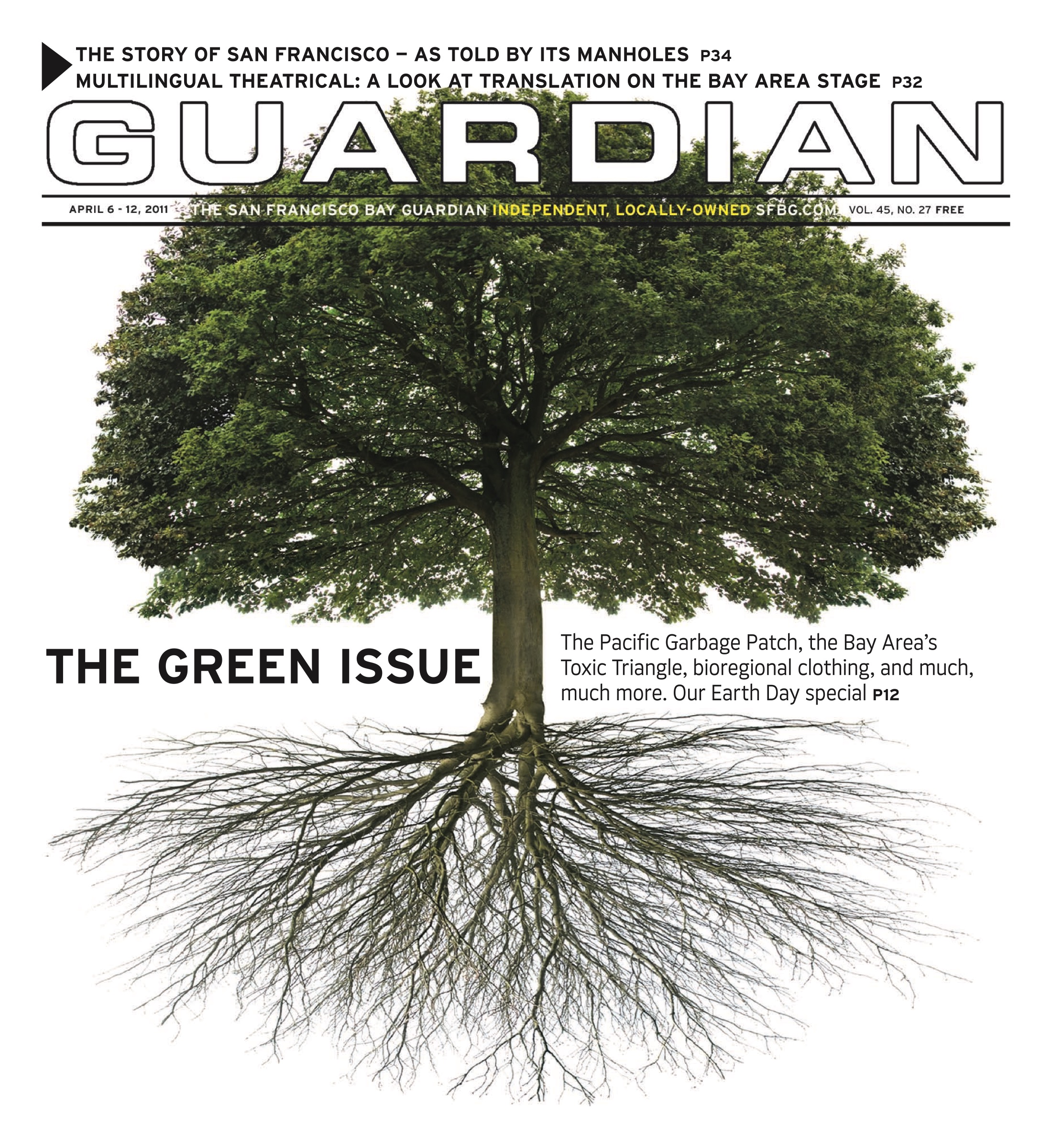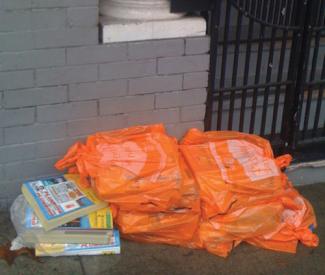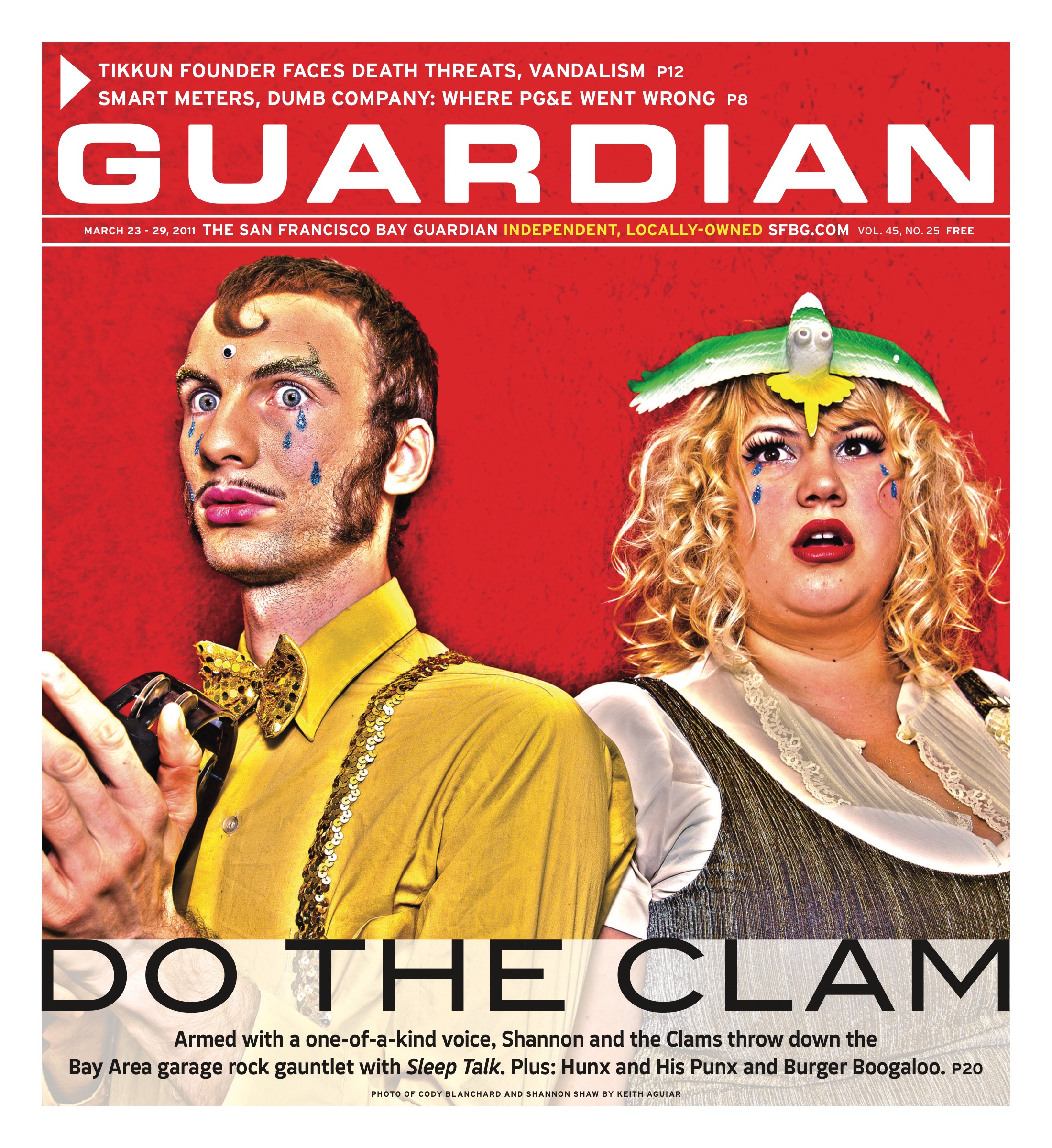Music listings are compiled by Cheryl Eddy. Since club life is unpredictable, it’s a good idea to call ahead to confirm bookings and hours. Prices are listed when provided to us. Submit items for the listings at listings@sfbg.com. For further information on how to submit items for the listings, see Picks.
WEDNESDAY 30
ROCK/BLUES/HIP-HOP
B Foundation, Katastro, Jahlectrik Bottom of the Hill. 9pm, $10.
Careerers, Le Mutant, Marmalade Mountain Hemlock Tavern. 9pm, $6.
DOM, Heavy Hawaii, Melted Toys, EpicSauce.com DJs Rickshaw Stop. 8pm, $10.
Ari Hest, Rosi Golan Café Du Nord. 8pm, $15.
Katchafire, Tomorrows Bad Seeds Independent. 9pm, $20.
Weapons of the Future, Tokyo Raid, Knives Knockout. 10pm, $6.
Mary Wilson Yoshi’s San Francisco. 8pm, $35.
Mitch Woods Biscuits and Blues. 8pm, $15.
Zodiac Death Valley, Preteen, Mata Leon Elbo Room. 9pm, $7.
JAZZ/NEW MUSIC
Cat’s Corner Savanna Jazz. 9pm, $10.
Cosmo Alleycats Le Colonial, 20 Cosmo, SF; www.lecolonialsf.com. 7pm.
Dink Dink Dink, Gaucho, Michael Abraham Amnesia. 7pm, free.
Guerrilla Cabaret with Tom Shaw Trio Martuni’s, Four Valencia, SF; www.dragatmartunis.com. 7pm.
Ben Marcato and the Mondo Combo Top of the Mark. 7:30pm, $10.
Michael Parsons Trio Revolution Café, 3248 22nd St, SF; (415) 642-0474. 8:30pm, free.
FOLK/WORLD/COUNTRY
Stevie Coyle Bazaar Café, 5927 California, SF; (415) 831-5620. 7pm.
Rose’s Pawn Shop, All My Pretty Ones Red Devil Lounge. 8pm, $6.
Matthew Santos, Chi McClean, Chris Gelbuda Hotel Utah. 8pm, $10.
David Wagner Café Royale, 800 Post, SF; www.caferoyale-sf.com. 8pm, free.
DANCE CLUBS
Booty Call Q-Bar, 456 Castro, SF; www.bootycallwednesdays.com. 9pm. Juanita Moore hosts this dance party, featuring DJ Robot Hustle.
Buena Onda Little Baobab, 3388 19th St., SF; (415) 643-3558. 10pm, $3. Soul, funk, swing, and rare grooves with residents Dr. Musco and DJB.
Cannonball Beauty Bar. 10pm, free. Rock, indie, and nu-disco with DJ White Mike.
Jam Fresh Wednesdays Vessel, 85 Campton, SF; www.vesselsf.com. 9:30pm, free. With DJs Slick D, Chris Clouse, Rich Era, Don Lynch, and more spinning top40, mashups, hip hop, and remixes.
Mary-Go-Round Lookout, 3600 16th St, SF; (415) 431-0306. 10pm, $5. A weekly drag show with hosts Cookie Dough, Pollo Del Mar, and Suppositori Spelling.
No Room For Squares Som., 2925 16th St, SF; (415) 558-8521. 6-10pm, free. DJ Afrodite Shake spins jazz for happy hour.
Respect Wednesdays End Up. 10pm, $5. Rotating DJs Daddy Rolo, Young Fyah, Irie Dole, I-Vier, Sake One, Serg, and more spinning reggae, dancehall, roots, lovers rock, and mash ups.
Salem, Water Borders, Whitch, Disco Shawn 103 Harriet, 1015 Folsom, SF; www.1015.com. 8pm, $10.
Synchronize Il Pirata, 2007 16th St, SF; (415) 626-2626. 10pm, free. Psychedelic dance music with DJs Helios, Gatto Matto, Psy Lotus, Intergalactoid, and guests.
THURSDAY 31
ROCK/BLUES/HIP-HOP
Alabama Mike Biscuits and Blues. 8 and 10pm, $15.
B-Stars Amnesia. 9pm, $5.
Dreamdate, Touch-Me-Nots, Elvis Christ Knockout. 9:30pm, $6.
Dreamdate, Touch-Me-Nots, Elvis Christ Knockout. 9:30pm, $6.
Frail Amoeba, 1855 Haight, SF; www.amoeba.com. 6pm, free.
Doug E. Fresh Yoshi’s San Francisco. 8 and 10pm, $20-26.
Brendan James and Matt White, Lauren Pritchard Red Devil Lounge. 8pm, $12.
Kem, Timothy Bloom Warfield. 8pm, $49.50-69.50.
Koalacaust, Steel Tigers of Death, King City Thee Parkside. 9pm, $7.
Travie McCoy, Donnis, Black Cards, XV, Bad Rabbits Slim’s. 7:30pm, $18.
Route 66 Players Revolution Café, 3248 22nd St, SF; (415) 642-0474. 8:30pm, free.
Southeast Engine, Pancho-san, Tommy Carns Bottom of the Hill. 9pm, $10.
JAZZ/NEW MUSIC
Dominique Leone, Meotar, Headshear Blue Macaw, 2565 Mission, SF; www.thebluemacawsf.com. 9pm.
Organsm featuring Jim Gunderson and “Tender” Tim Shea Bollyhood Café. 6:30-9pm, free.
Pascal Bokar Band and Alan Benzie’s Berklee College of Music Band Savanna Jazz. 7:30pm, $10.
Stompy Jones Top of the Mark. 7:30pm, $10.
“Tingel Tangel Club: Three Year Anniversary Party” Café Du Nord. 9pm, $16-20. Cabaret with Ann Magnuson and Kristian Hoffman, Uni and Her Ukelele, Scotty the Blue Bunny, and more.
FOLK/WORLD/COUNTRY
Bluegrass and old-time jam Atlas Café. 8-10pm, free.
Prince Royce Regency Ballroom. 8pm, $38.
“Twang! Honky Tonk” Fiddler’s Green, 1330 Columbus, SF; www.twanghonkytonk.com. 5pm.
DANCE CLUBS
Afrolicious Elbo Room. 9:30pm, $5. DJs Pleasuremaker and Señor Oz spin Afrobeat, tropicália, electro, samba, and funk.
Bag Raiders, DJs Aaron Axelsen, Omar, and KidHack Rickshaw Stop. 9:30pm.
Base Vessel, 85 Campton, SF; www.vesselsf.com. 10pm, $10. With Roger Sanchez.
Caribbean Connection Little Baobab, 3388 19th St, SF; (415) 643-3558. 10pm, $3. DJ Stevie B and guests spin reggae, soca, zouk, reggaetón, and more.
Drop the Pressure Underground SF. 6-10pm, free. Electro, house, and datafunk highlight this weekly happy hour.
80s Night Cat Club. 9pm, $6 (free before 9:30pm). Two dance floors bumpin’ with the best of 80s mainstream and underground with Dangerous Dan, Skip, Low Life, and guests.
Jivin’ Dirty Disco Butter, 354 11th St., SF; (415) 863-5964. 8pm, free. With DJs spinning disco, funk, and classics.
Mestiza Bollywood Café, 3376 19th St, SF; (415) 970-0362. 10pm, free. Showcasing progressive Latin and global beats with DJ Juan Data.
1984 Mighty. 9pm, $2. The long-running New Wave and 80s party has a new venue, featuring video DJs Mark Andrus, Don Lynch, and celebrity guests.
Peaches Skylark, 10pm, free. With an all female DJ line up featuring Deeandroid, Lady Fingaz, That Girl, and Umami spinning hip hop.
Thursday Special Tralala Revolution Café, 3248 22nd St, SF; (415) 642-0474. 5pm, free. Downtempo, hip-hop, and freestyle beats by Dr. Musco and Unbroken Circle MCs.
Wax Candy Showdown, 10 Sixth St, SF; www.showdownsf.com. 9pm, free. Disco, funk, house, and techno with Sergio, the Worker, André Lucero, and Travis Dalton.
FRIDAY 1
ROCK/BLUES/HIP-HOP
Ashford and Simpson Rrazz Room. 8pm, $55.
Seth Augustus Revolution Café, 3248 22nd St, SF; (415) 642-0474. 9pm, free.
Ben, Ian, and Tom of Gomez Swedish American Hall (upstairs from Café Du Nord). 8pm, $25.
Books on Tape, Downer Party, Nero Nava Bottom of the Hill. 10pm, $10.
De La Soul Yoshi’s San Francisco. 8 and 10pm, $45.
Galactic, Cyril Neville, Corey Henry and Rebirth Brass Band Fillmore. 9pm, $29.50.
Last Nova, Untied, Fever Charm, Distorted Harmony, Amply Hostile Slim’s. 7:30pm, $15.
Lenka, Greg Laswell Rickshaw Stop. 8:30pm, $14.
Stung, Petty Theft Café Du Nord. 9:30pm, $15.
“Thee Parkside Anniversary Party” Thee Parkside. 9pm, free. With Glen Meadmore and His Hot Horny Born Again Revue.
Walken, Lozen, Dog Shredder, Pins of Light Hemlock Tavern. 9:30pm, $8.
JAZZ/NEW MUSIC
Black Market Jazz Orchestra Top of the Mark. 9pm, $10.
FOLK/WORLD/COUNTRY
BeauSoliel aves Michael Doucet Great American Music Hall. 8pm, $25.
Head for the Hills Boom Boom Room. 9:30pm, $10.
Rupa and the April Fishes, Rumen Sali Shopov and the Soul of the Mahala, Sani Rifati and Mahala Blaster, DJ Zeljko Independent. 9pm, $20.
Tony Ybarra and Sonido Moreno Red Poppy Art House. 8pm, $10-15.
DANCE CLUBS
Afro Bao Little Baobab, 3388 19th St, SF; (415) 643-3558. 10pm, $5. Afro and world music with rotating DJs including Stepwise, Steve, Claude, Santero, and Elembe.
Aural Fixation with Kool Keith Club Six. 9pm, $15. Plus DJ Godfather, Dials, Prince Zammy, and Ryury.
DJ Scott Cams Medjool, 2522 Mission, SF; www.medjoolsf.com. 10:30pm, $10.
ESL Music Showcase Public Works, 161 Erie, SF; www.publicsf.com. 10pm, $15. With Rob Garza, Ancient Astronauts, and Afrolicious DJs.
Exhale, Fridays Project One Gallery, 251 Rhode Island, SF; (415) 465-2129. 5pm, $5. Happy hour with art, fine food, and music with Vin Sol, King Most, DJ Centipede, and Shane King.
Fubar Fridays Butter, 354 11th St., SF; (415) 863-5964. 6pm, $5. With DJs spinning retro mashup remixes.
Good Life Fridays Apartment 24, 440 Broadway, SF; (415) 989-3434. 10pm, $10. With DJ Brian spinning hip hop, mashups, and top 40.
Hot Chocolate Milk. 9pm, $5. With DJs Big Fat Frog, Chardmo, DuseRock, and more spinning old and new school funk.
Mix-Up! 540 Club, 540 Clement, SF; www.540-club.com. 10pm, free. DJ Ben Abstrakt plays indie, new wave, dance, and more.
Oldies Night Knockout. 9pm, $2-4. Doo-wop, one-hit wonders, and soul with DJs Primo, Daniel, and Lost Cat.
120 Minutes Elbo Room. 10pm, $5-10. Witch house with DJs oOoOO, Whitch, Nako, and White Ring.
Rockabilly Fridays Jay N Bee Club, 2736 20th St, SF; (415) 824-4190. 9pm, free. With DJs Rockin’ Raul, Oakie Oran, Sergio Iglesias, and Tanoa “Samoa Boy” spinning 50s and 60s Doo Wop, Rockabilly, Bop, Jive, and more.
Some Thing Stud. 10pm, $7. VivvyAnne Forevermore, Glamamore, and DJ Down-E give you fierce drag shows and afterhours dancing.
Strangelove Cat Club. 9:30pm, $6. Goth, industrial, and plenty of surprises with DJs Tomas Diablo, Melting Girl, Mitch, and more.
Vintage Orson, 508 Fourth St, SF; (415) 777-1508. 5:30-11pm, free. DJ TophOne and guest spin jazzy beats for cocktalians.
SATURDAY 2
ROCK/BLUES/HIP-HOP
American Steel, Yi, Cat Party, Hanalei Thee Parkside. 9:30pm, $12.
Ashford and Simpson Rrazz Room. 7 and 9:30pm, $55.
Baseball Project, Minus 5, Steve Wynn Slim’s. 9pm, $17.
Big Bang Revolution Café, 3248 22nd St, SF; (415) 642-0474. 9pm, free.
De La Soul Yoshi’s San Francisco. 8 and 10pm, $45.
Doormats, Daisy Chain Thee Parkside. 3pm, free.
Galactic, Cyril Neville, Corey Henry and Rebirth Brass Band Fillmore. 9pm, $29.50.
Hunx and His Punx, Shannon and the Clams, Grass Widow Bottom of the Hill. 10pm, $10.
Ivan Neville’s Dumpstaphunk, Zigaboo Modeliste and the New Aahkesstra Independent. 9pm, $22.
Nibblers Shine SF, 1337 Mission, SF; www.shinesf.com. 9pm.
Sex With No Hands Ireland’s 32. 10pm, free.
Trophy Fire, I Was Totally Destroying It, Glass Trains Hemlock Tavern. 9:30pm, $7.
JAZZ/NEW MUSIC
Marcus Shelby Trio Herbst Theatre, 401 Van Ness, SF; www.sfjazz.org. 11am, $5-15.
John Santos Herbst Theatre, 401 Van Ness, SF; www.sfjazz.org. 8pm, $19-60.
FOLK/WORLD/COUNTRY
“Americana Jukebox” Plough and Stars. 9:30pm, $6-10. With Hang Jones and Susan James.
Hot Buttered Rum String Band with guests Great American Music Hall. 8pm, $21.
Lee MacDougall Elbo Room. 6-9pm, $10.
Belle Monroe and her Brewglass Boys, California Honeydrops, Windy Hill Bluegrass Band Café Du Nord. 9pm, $12.
Craig Ventresco and Meredith Axelrod Atlas Café. 4pm, free.
DANCE CLUBS
Afro Bao Little Baobab, 3388 19th St, SF; (415) 643-3558. 10pm, $5. Afro and world music with rotating DJs including Stepwise, Steve, Claude, Santero, and Elembe.
Bardot A Go Go’s Serge Gainsbourg Birthday Dance Party Rickshaw Stop. 9pm, $10. French pop.
Bootie SF DNA Lounge. 9pm, $6-12. Mash-ups.
Bridge 2 MIghty. 10pm, $10. Eclectic dance music with Deekline, Udachi, and Qdup Foundation.
Debaser Knockout. 9pm, $5. Fly your flannel at this 90s alternative party with DJ Jamie Jams and EmDee.
DJ Duserock Medjool, 2522 Mission, SF; www.medjoolsf.com. 10:30pm, $10.
HeroesNHunks Truck, 1900 Folsom, SF; (415) 252-0306. 6pm. Superhero-themed party with an XXX twist.
HYP Club Eight, 1151 Folsom, SF; www.eightsf.com. 10pm, free. Gay and lesbian hip-hop party, featuring DJs spinning the newest in the top 40s hip hop and hyphy.
Mount Kimble, Shigeto, Matthew David Mezzanine. 9pm, $15.
Rock City Butter, 354 11th St., SF; (415) 863-5964. 6pm, $5 after 10pm. With DJs spinning party rock.
Saturday Night Soul Party Elbo Room. 10pm, $10. Soul with DJs Lucky, Phengren Oswald, and Paul Paul.
Spirit Fingers Sessions 330 Ritch. 9pm, free. With DJ Morse Code and live guest performances.
SUNDAY 3
ROCK/BLUES/HIP-HOP
Ashford and Simpson Rrazz Room. 7pm, $55.
A Day to Remember, Bring Me the Horizon, We Came as Romans, Pierce the Veil Warfield. 7pm, $27.
Ferraby Lionheart, Henry Wolfe, Charlie Wadhams Café Du Nord. 8pm, $12.
Gears, Controllers, Poop Hemlock Tavern. 8:30pm, $10.
Helmet, Saint Vitus, Crowbar, Kylesa, Red Fang, Howl, Atlas Moth Mezzanine. 8pm, $25.
Middle Brother, Blake Mills Independent. 8pm, $20.
Dorian Wood Viracocha, 998 Valencia, SF; (415) 374-7048. 8pm.
Young Prisms Knockout. 9pm, $6.
JAZZ/NEW MUSIC
Daria Bliss Bar, 4026 24th St., SF; www.blissbarsf.com. 4:30pm, $10.
Swing-out Sundays Milk Bar. 9pm, $7-15. With beginner swing lessons.
“Switchboard Music Festival” Brava Theater, 2781 24th St, SF; www.switchboardmusic.com. 2-10pm, $15-40. Marathon concert with Birds and Batteries, Causing a Tiger, Loren Chasse, Genie, Gojogo, and more.
Tom Lander Duo Medjool, 2522 Mission, SF; www.medjoolsf.com. 6-9pm, free.
FOLK/WORLD/COUNTRY
Family Folk Explosion Revolution Café, 3248 22nd St, SF; (415) 642-0474. 8:30pm, free.
Gentry Bronson, Rachel Efron, Kate Isenberg Yoshi’s San Francisco Lounge. 8pm, $7.
Dang Show Yoshi’s San Francisco. 7pm, $35.
Slow Poisoner, Naked and Shameless Thee Parkside. 4pm, free.
DANCE CLUBS
Batcave Cat Club. 10pm, $5. Death rock, goth, and post-punk with Steeplerot Necromos and c_death.
Dub Mission Elbo Room. 9pm, $7. Dub, roots, and classic dancehall with DJ Sep, Vinnie Esparza, and guest Kush Arora.
Gloss Sundays Trigger, 2344 Market, SF; (415) 551-CLUB. 7pm. With DJ Hawthorne spinning house, funk, soul, retro, and disco.
Honey Soundsystem Paradise Lounge. 8pm-2am. “Dance floor for dancers – sound system for lovers.” Got that?
La Pachanga Blue Macaw, 2565 Mission, SF; www.thebluemacawsf.com. 6pm, $10. Salsa dance party with live Afro-Cuban salsa bands.
MONDAY 4
ROCK/BLUES/HIP-HOP
Saturn, KaeRo, Zutra El Rio. 7pm, $7.
Seasick Steve Slim’s. 7:30pm, $15.
Witchburn, Betty White Hemlock Tavern. 6pm, $5.
JAZZ/NEW MUSIC
Phil Manley, Sean Smith, Ava Mendoza Elbo Room. 9pm, $10.
Lavay Smith Orbit Room, 1900 Market, SF; (415) 252-9525. 7-10pm, free.
DANCE CLUBS
Death Guild DNA Lounge. 9:30pm, $3-5. Gothic, industrial, and synthpop with Joe Radio, Decay, and Melting Girl.
Krazy Mondays Beauty Bar. 10pm, free. With DJs Ant-1, $ir-Tipp, Ruby Red I, Lo, and Gelo spinning hip hop.
M.O.M. Madrone Art Bar. 6pm, free. With DJ Gordo Cabeza and guests playing all Motown every Monday.
Network Mondays Azul Lounge, One Tillman Pl, SF; www.inhousetalent.com. 9pm, $5. Hip-hop, R&B, and spoken word open mic, plus featured performers.
Sausage Party Rosamunde Sausage Grill, 2832 Mission, SF; (415) 970-9015. 6:30-9:30pm, free. DJ Dandy Dixon spins vintage rock, R&B, global beats, funk, and disco at this happy hour sausage-shack gig.
Skylarking Skylark. 10pm, free. With resident DJs I & I Vibration, Beatnok, and Mr. Lucky and weekly guest DJs.
TUESDAY 5
ROCK/BLUES/HIP-HOP
Sarah Allner, Brian Weeber El Rio. 7pm, free.
Ryan Bisio, Gwyneth and Monko, Ben Jordan Hotel Utah. 8pm, $10.
Erin Brazill and the Brazillionaires, Annie Bacon and Her Oshen, Love Axe Bottom of the Hill. 8:30pm, $8.
British Sea Power, A Classic Education, Sporting Life Independent. 8pm, $16.
Crackerjack Highway, Fulton and 44th Rickshaw Stop. 7pm, $12. Benefit for Boys Hope Girls Hope of San Francisco.
Das Butcher, Rodney J. Cooper, Chronox Hemlock Tavern. 9pm, $5.
Donion, Outlaws and Preachers 50 Mason Social House, 50 Mason, SF; www.50masonsocialhouse.com. 9pm, free.
Giant Panda Guerilla Dub Squad, Kevin Kinsella Café Du Nord. 9pm, $12.
Talib Kweli Fillmore. 8pm, $28.50.
Sydney Ducks, Face the Rail, Go Time, DJ Mackiveli, DJ Taypoleon Knockout. 8:30pm, $5.
Yeallow, Secret Secretaries, General Bye Bye, Interchangeable Hearts Kimo’s. 9pm.
Pete Yorn, Ben Kweller, Wellspring Regency Ballroom. 8pm, $30.
DANCE CLUBS
Benefit for Capoeira Brasil Elbo Room. 9pm, $5. Brazilian dance hits, samba, and more with DJs Dion and Kwala.
Boomtown Little Baobab, 3388 19th St, SF; www.bissapbaobab.com. 9pm, free. DJ Mundi spins roots, ragga, dancehall, and more.
Eclectic Company Skylark, 9pm, free. DJs Tones and Jaybee spin old school hip hop, bass, dub, glitch, and electro.
Share the Love Trigger, 2344 Market, SF; (415) 551-CLUB. 5pm, free. With DJ Pam Hubbuck spinning house






